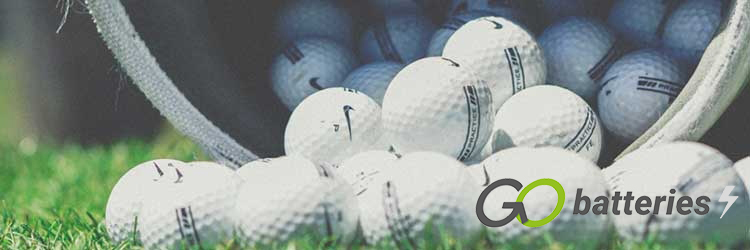
Charging your Golf Batteries

Here we are going to look at charging various battery technologies for Golf Carts and Trolleys.
Charging your AGM Lead-Acid Battery
- Place your battery and charger on a hard surface and connect the battery and charger first before plugging in the mains power and switching on.
- The charger will have a series of lights (depending on the manufacturer of the charger), mainly two lights. When connecting a discharged battery, usually there will be a red light illuminated (but please consult your user manual to understand your charger). The battery must remain on charge for a minimum of 12 hours.
- Never leave the charger connected to the battery with the mains supply switched off.
- We would recommend you recharge your battery within 24 hours of use no matter how many holes you’ve played.
- This could take up to 12 hours for AGM Lead-Acid batteries depending on the capacity of the battery and the depth of discharge when recharging.
- Never leave your battery in a discharged state for prolonged periods, this will greatly reduce the life of the battery and you may be unable to recharge the battery.
- If the battery is not going to be used for an extended period then always recharge the battery prior to storing it. Thereafter recharge the battery every 6-8 weeks.
- New Lead-Acid batteries may take 2 or 3 rounds of golf before becoming fully activated.
- If you have any concerns then please refer to your product manual or contact your local dealership.

Charging Deep Cycle Batteries
U.S. Battery Manufacturing Company, Inc. recommends the use of ‘opportunity charging’ or charging batteries and battery packs at every opportunity while in storage or service. Following this recommendation will assure that batteries are always at the highest possible State of Charge (SOC) to maximise performance and range and to minimise the battery’s Depth of Discharge (DOD) to optimise performance and life.
The charging process is intended to fulfill several objectives. First, the charging process should replace the capacity (in amp-hours) removed from the battery during previous discharges. Second, the charging process should return additional capacity (in amp-hours) to offset the thermodynamic inefficiencies inherent in the charging process. This additional capacity can be measured as a charge factor calculated by: charge Ah in / discharge Ah out. The charge factor varies with temperature, condition, and age of the battery but is usually in the range of 105 – 150%. Third, the charging process should charge the battery at a voltage and/or charge rate at the end of charge that will result in the controlled gassing of the electrolyte. This gassing is required to mix the electrolyte to prevent stratification. Without proper mixing of the electrolyte, the heavier acid generated during charging can sink to the bottom of the cell and will adversely affect the performance and life of the battery. Finally, the charging process should result in a fully charged battery with electrolyte specific gravity that is constant over several end-of-charge readings, consistent between and among the cells of the battery pack, and within the proper range for the battery type per U.S. Battery’s specifications.
- Three-Stage Charging – Charging using bulk charge, absorption charge, and finish charge (usually constant current – constant voltage – constant current).
- Two-Stage Charging – Charging using bulk charge and absorption charge only (usually constant current – constant voltage).
- Single-Stage (Ferroresonant) Charging – Charging using a single-stage charge with tapering current and voltage.
U.S. Battery’s charging recommendations for Deep-Cycle Flooded Lead-Acid (FLA), and sealed Absorptive Glass Mat (AGM) batteries are attached. Note that the charging parameters recommended for each of these depend on both the battery type and charger type. These charging parameters are often controlled by specific charge algorithms that can be selected or programmed by the user. Users should consult the charger manufacturer and/or U.S. Battery for proper selection or programming of algorithm controlled chargers. U.S. Battery prefers the use of Three-Stage Charging with dV/dt charge termination to minimise the charge time required for full charge and to reduce the risk of abusive undercharging or overcharging of batteries and battery packs.
DOWNLOAD THE FULL DETAILED CHARGING INSTRUCTIONS
Charging Lithium Iron Phosphate Batteries
Everything You Need to Know About Charging Lithium Iron Phosphate (LiFePO4) Batteries
Change can be daunting, even when switching from a Lead-Acid battery to a Lithium Iron Phosphate battery. Properly charging your battery is critical and directly impacts the performance and life of the battery. Discover how to charge your Relion LiFePO4 battery to maximise your investment.
Charging Conditions
Much like your mobile phone, you can charge your Lithium Iron Phosphate batteries whenever you want. If you let them drain completely, you won’t be able to use them until they get some charge. Unlike lead-acid batteries, Lithium Iron Phosphate batteries do not get damaged if they are left in a partial state of charge, so you don’t have to stress about getting them charged immediately after use.
Relion LiFePO4 batteries can safely charge at temperatures between -4°F – 131°F (0°C – 55°C) – however, we recommend charging in temperatures above 32°F (0°C). If you do charge below freezing temperatures, you must make sure the charge current is 5-10% of the capacity of the battery.
How to Charge a LiFePO4 Battery
The ideal way to charge a LiFePO4 battery is with a Lithium Iron Phosphate battery charger, as it will be programmed with the appropriate voltage limits. Most lead-acid battery chargers will do the job just fine. AGM and GEL charge profiles typically fall within the voltage limits of a Lithium Iron Phosphate battery. Wet lead-acid battery chargers tend to have a higher voltage limit, which may cause the Battery Management System (BMS) to go into protection mode. This won’t harm the battery; however, it may cause fault codes on the charger display.
Charging batteries in Parallel Best Practices
When connecting your Lithium batteries in parallel, it is best to charge each battery individually before making the parallel connection(s). If you have a voltmeter, check the voltage a couple hours after the charge is complete and make sure they are within 50mV (0.05V) of each other before paralleling them. This will minimise the chance of imbalance between the batteries and maximise the performance of the system. Over time, if you notice the capacity of your battery bank has decreased, disconnect the parallel connections and charge each battery individually, then reconnect.
Charging Batteries in Series Best Practices
Connecting Lithium batteries in series is much like connecting them in parallel, it is best to charge each battery up individually and check the voltage and ensure they are within 50mV (0.05V) of each other before making the series connections.
It is highly recommended to charge Lithium batteries in series with a multi-bank charger. This means each battery is charged at the same time but completely independent of the other. In some applications, this is not practical, which is why Relion offers 24V and 48V batteries to reduce the need for multiple batteries in series.
What About During Storage?
Lithium Iron Phosphate batteries are so much easier to store than lead-acid batteries. For short-term storage of 3-6 months, you don’t have to do a thing. Ideally, leave them at around 50% state of charge before storing. For long-term storage, it is best to store them at a 50% state of charge and then cycle them by discharging them, recharging them and then partially discharging them to approximately 50%, every 6-12 months.
The Key Differences Between Lithium Iron Phosphate and Lead-Acid Batteries When It Comes to Charging
Lithium batteries can charge at a much higher current and they charge more efficiently than lead-acid, which means they can be charged faster. Lithium batteries do not need to be charged if they are partially discharged. Unlike lead-acid batteries, which when left in a partial state of charge will sulfate, drastically reducing performance and life.
Relion Lithium batteries come with an internal Battery Management System (BMS) that protects the battery from being over-charged, whereas lead-acid batteries can be over-charged, increasing the rate of grid corrosion and shortening battery life.
For more details on charging your Relion Lithium batteries, check out our Charging Instructions and Contact us if you have any questions.

















